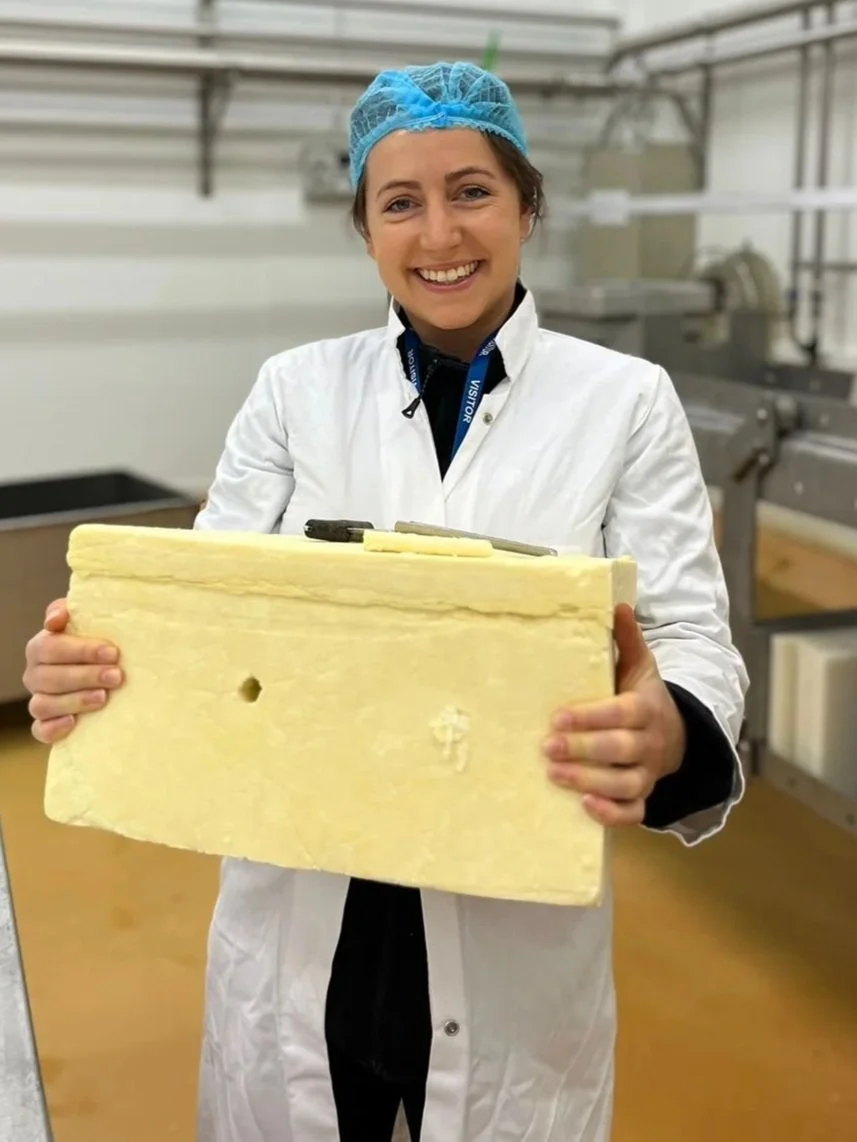Being a student again is fun (Academy of Cheese - Level 2 )
Back in January 2024, I started the Level 2 course at the Academy of Cheese. I went to Northern Ireland to learn how to make Ricotta, Cheddar, and Brie. The lovely Katy and Lee-Anna taught the course and I LOVED IT. As well as the practical, hands-on cheesemaking, we also studied some of the theory and A LOT of science that really brought me back to my secondary school days.
A very proud Lucy and a block of cheddar that we made in the CAFRE: College of Agriculture, Food and Rural Enterprise
Each week before March (when I shall take the scary exam), I am going to base my blogs on my learnings from the course. This will help me to regurgitate what I have learnt and also provide some helpful insight into cheese making for you to read (I hope!).
There are 10 modules and within each module there are a number of standards (totaling to 51) plus several assessments embedded into each module. The first module is all about Milk Production and Cheesemaking. Last week I wrote a lot of notes on Standard one which focuses on the types of cultures, moulds, and starters that help with cheesemaking.
There are types of acidifying cultures and fermentation that I have displayed in a table below which also provides examples of which cultures may be added to a particular type of cheese:
Moulds
The moulds present in cheese ripening help to develop flavour + texture, these can include:
-Penicillium roqueforti (requires oxygen so these cheeses are pierced with stainless steel needles when they are ripening, eg Roquefort, Gorgonzola, Stilton)
-Penicillium Candidum/P. Camemberti (Brie, Camembert)
Yeasts
The yeasts species contribute to appearance/texture/aroma/flavour/rind as well as surface ripening, they are not just one sole species, yeast examples:
-Geotrichum Candidum (think of the wrinkly-brain-like cheeses i.e. Brie and Camembert)
Bacteria to ripen
-Brevibacterium linens (the sticky pink/orange surface of washed rind cheese such as Stinking Bishop/Munster/Epoisses)
Some cheesemakers’ maturing rooms have particular bacteria that naturally inhabit the environment, however, some cheesemakers opt to buy in the bacteria to ensure they have the correct environment for such moulds to survive and help produce the outcome of the rind/flavour/appearance that they wanted. The ‘bought in’ bulk starters that are often supplied are called DVI (Direct Vat Inoculation) cultures.
Types of starters:
-DVIs
This starter needs to be cultured in milk overnight and it creates a thick yoghurt like liquid, you can also buy
A pint starter (culture frozen in milk)
A freeze dried powder bulk starters
-Whey starters
Adding a proportion of whey from the previous day AKA “back slopping” (love this word!)
-Thermophilic whey starters
Used in Alpine and Grana style cheeses
-Mesophilic whey starter
Used in soft lactic cheeses
How milk coagulates: by acidification or enzymatically using rennet
Milk’s protein is about 80% casein and 20% whey proteins. But casein isn’t just floating around freely - it’s organised into complex structures called micelles.
Casein micelle = the natural, stable structure of casein proteins in milk, held together by calcium phosphate bridges and coated with κ-casein (“hairy coating”).
Milk casein curd (sometimes called casein clot or casein curd)
When milk coagulates (by acidification or rennet), the casein micelles destabilise and aggregate (clump together) to form a curd:
Rennet cuts the κ-casein “hairs” on the micelle surface, removing their stability
The micelles then stick together, trapping fat and water in a gel-like network - the curd
This curd is what becomes cheese once it’s drained and matured
Questions I ask myself daily and need to be reminded of constantly :
What do starter cultures do? Acidify the milk turning lactose into lactic acid, what you add right at the beginning of cheesemaking - usually as DVI powders straight into the milk.
What do ripening cultures do? These are added after or alongside the starter, this group includes : yeasts, moulds, and surface bacteria (for flavour, rind, and texture development)
What is a lactic set cheese? Lactic set cheese is a cheese made primarily by acidifying milk with lactic acid bacteria, causing the milk proteins to coagulate and form a curd, rather than relying on rennet. This process results in a weaker, more delicate curd that is typically drained without pressing, leading to soft, fresh cheeses or small, aged round cheeses (St. Marcellin, Dorstone, many Chèvres although Crottin de Chavignol contains a small dose of rennet but coagulation is predominantly lactic)
Just for reference, this is only one standard out of 51!
Now onto Standard 2….

